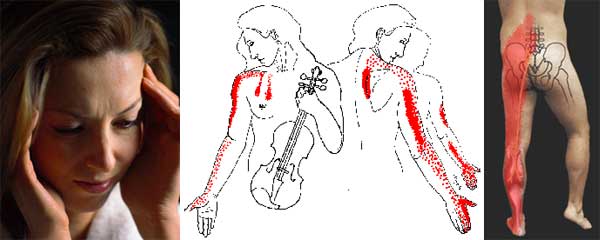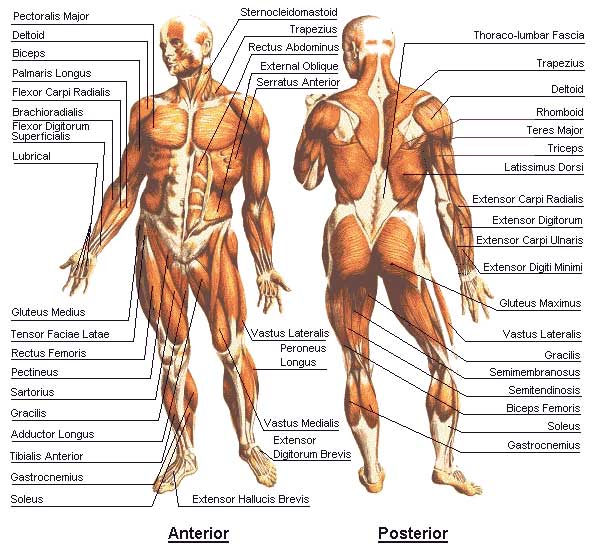Typically, one of 3 causes is responsible for your musculo-skeletal pain.
- Direct physical trauma
- Poor posture
- Stress
It is very likely that you can trace the source of your aches and pains back to one of these mechanisms, or even a combination of two or three of these.
Direct Physical Trauma
Direct physical trauma can be from a number of sources:
- Sport’s Injury
- Car Crash
- Fall
- Trying to lift a heavy object
- Repetitive Strain
- Overloading your body with a physical activity (e.g. painting, gardening etc.)
Some more common examples of physical trauma you may have experienced are:
- Spraining your ankle
- Suddenly overloading muscles that you have used rarely (e.g. gardening)
- Whiplash injury to your neck during a vehicle collision
Physical trauma can result in the following dysfunctions:
- Muscle Spasm
- Torn muscle/ligament/tendon fibres
- Dislocation
- Inflammation
- Swelling
Some or all of these factors can contribute to pain after a physical trauma. [1]
Poor Posture
Your ache may also be as a result of poor posture. This can be the case if your occupation involves any of the following:
- Sitting at a desk
- Working on a computer
- Driving long journeys
Any of these occupations that put your body in unnatural positions for prolonged periods of time will inevitably take their toll on your body’s muscle system. Prolonged placement of your body in these unnatural positions will cause your musculature to become short and hold increased tension. This contraction of your muscles eventually leads to pain. [2]
Stress
The third and often forgotten cause of musculoskeletal pain is stress. Some examples of stress that that you may have experienced include
- Bereavement
- Work Stress
- Exam Stress
- Relationship
- Financial
When you are subjected to stress, the following 3 chemicals are released into your system:
- Epinephrine
- Nor-epinephrine
- Cortisol
One effect that these 3 chemicals have on your body is an increase in muscle tension.
This increase in muscle tension leads to the following occurrences:
- Build up of metabolic wastes and toxins
- Lack of oxygen reaching muscles
- An increase in fluid retention
As a result, sustained periods of stress in your life leads to chronic aches and pain. [3]

The Dysfunctions at the root of your pain
Now that we have looked at the mechanisms/causes of your aches and pains, we can turn our attention to the actual painful states themselves. Generally, your painful state will be because of one of (or a combination of) the following:
- Muscular Dysfunction
- Joint Misalignment
- Disc Dysfunction
Muscular Dysfunction
Muscular dysfunction is the most common of the three pathologies. If your body is subjected to poor posture positions, trauma or a sustained period of stress, some of your muscles can become dysfunctional. When this happens, your affected muscles become painful and unable to perform movements that they can normally accomplish.
Joint Misalignment
Joint misalignment is the next most common of the three pathologies. This can take place by direct trauma to the joint, for example:
- Twisting an ankle/knee during sport
- A fall to the ground
This can also happen indirectly over a longer period of time. Dysfunctional muscles become tight, and as these are attached to bones/joints, they can pull bones/joints out of line.
Disc Dysfunction
Disc dysfunctions are the least common of the three pathologies. Some simple disc dysfunctions can be successfully treated without the need for surgery, but more serious problems may require surgical intervention.
Your dysfunction can progress to being a more complex condition if left unaddressed
Your dysfunctions may be simple at its initial onset. However, if not addressed in its early stage, it may progress to being a more complex dysfunction. For example
- A pain or ache that initially started in a small area of your shoulder or neck may progress down your arm and/or begin to cause headaches.
- A pain or ache that initially started in a small area of your lower back may progress down into your buttock and/or your leg region

This can happen for a number of reasons:
- Dysfunctional muscles hold increased tension. As a result, this tension “pulls” on bones that the muscle is attached to. This can create joint/spinal alignment problems. In this case, even when joint/spinal alignment is corrected, this “pulling” force will pull these bones out of alignment again. In order for you to retain long-lasting relief, dysfunctional muscles must be corrected to prevent them from continually pulling your joints/spine out of alignment.
- When one muscle becomes dysfunctional, it becomes incapable of efficiently performing the movement that it normally does. As a result, other muscles in that region begin to compensate to help and assist the dysfunctional muscle. Over time, these compensating muscles also become dysfunctional, as they are unable to cope with the additional load.
This explains how an ache or pain that starts in one region may spread to other areas over a period of time.
References:
- Barlow T, Willoughby J 1992 Pathophysiology of soft tissue repair.
British Medical Bulletin 48(3):698-711 - Dvorak J, Dvorak 1984
Manual Medicine – Diagnostics.
Georg Thiem Verlag Thieme-Stratton, Stuttgart - Sandman K 1984
Psychophysiological factors in myofascial pain.
Journal of Manipulative and Physiological Therapeutics 7(4):237-242
Learn more about our approach to resolving your painful condition.






